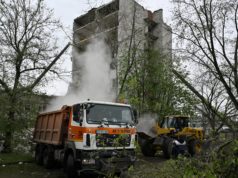The world's only water ambassador, appointed by the Netherlands, says damage from hurricanes could be lessened with the help of Dutch-innovated stormwater management
Parts of the country ravaged by Hurricane Florence will slowly dry out and begin to clean up in the coming weeks. Many communities in the Carolinas hadn’t yet recovered from Hurricane Matthew two years ago. The relentless cycle of disaster, rebuild, repeat has many coastal residents feeling numb and helpless. And climate scientists say we can expect more frequent, more powerful storms in the future.
We heard that the Netherlands, one of the most flood-prone places in the world, almost never floods. Holland is about twice the size of New Jersey and is one of the world’s most densely populated countries. Much of it is below sea level, yet the Dutch don’t bother with flood insurance. They don’t need it. As the U. S. cleans up from Hurricane Florence, we were wondering, do the Dutch have a solution?
It was a disaster that unfolded in slow motion. For four days Hurricane Florence crawled up the East Coast dumping record rainfall – more than 35 inches in North Carolina – flooding thousands of homes and taking dozens of lives.
The destruction from Hurricanes Katrina, Sandy, Harvey and Maria cost hundreds of billions of dollars. Florence is another chapter in a story we know all too well.
We met a Dutchman – Henk Ovink – who says it’s time to rewrite America’s disaster playbook entirely.
Henk Ovink: There’s only one opportunity. That is when a disaster hits. It’s like a X-ray. It tells you where all your vulnerabilities are and gives you the opportunity to step up and say, “We can do better.”
Ovink is the world’s only water ambassador, a role given to him by the Dutch government.
He advises the U. N., 35 individual countries, and a dozen U. S. cities. He travels the globe like a missionary preaching the gospel of flood prevention. One of his latest stops was Houston, still recovering from Hurricane Harvey.
Bill Whitaker: So What’s the biggest challenge in the United States?
Henk Ovink: You’re solution oriented. You have a collective. When things happen, you come together. You wanna build back and repair and be ready when disastrous things happen. But there’s not so much a belief that you can actually prevent a disaster from happening.
Bill Whitaker: But how do you go about preventing a disaster like Katrina, Harvey, Sandy? It– it just doesn’t seem possible.
Henk Ovink: We can’t prevent them from happening. But the impact that is caused by these disasters, we can decrease by preparing ourselves. I think the catastrophes we see in the world are all man-made. The storms are perhaps man-caused and you can debate that. But the catastrophes because of the storms? Uh. Those are man-made.
It’s a radical statement. We went with him to the Netherlands to learn what shaped his thinking: it’s water. Water is everywhere in this country known for its charming canals, picturesque dikes and windmills. But they’re not just quaint tourist attractions. For centuries the canals and dikes have held back water, the windmills pump it away. Ovink took us up in a helicopter so we could see it from above.
Bill Whitaker: From what I can see here, it looks as though the entire country is man-engineered.
Henk Ovink: Yes
We flew over Rotterdam, his hometown, so he could show us how the country has been engineered.
Bill Whitaker: How much of this city is below sea level?
Henk Ovink: Almost everything.
Bill Whitaker: When was the last time this flooded?
Henk Ovink: This doesn’t flood. And we–
Bill Whitaker: Because of the precautions you have taken.
Henk Ovink: Yeah.
The Dutch allocate more than a billion dollars a year to manage their flood infrastructure. Some of it is massive, like the Maeslantkering storm surge barrier.
Bill Whitaker: Oh, this is, these are the gates.
Henk Ovink: They’re big.
Bill Whitaker: They’re enormous.
Henk Ovink: It’s like an Eiffel Tower, like the Paris Eiffel Tower, on its sides. But then two.
Bill Whitaker: Each one the size of the–
Henk Ovink: Each one.
Bill Whitaker: –Eiffel Tower.
The gates guard one of the largest ports in the world and most of the Dutch population. They don’t have hurricanes like we do, but ferocious storms with hurricane-force winds can blow in from the North Sea and push in huge storm surges. When that happens, the two arms seal off the Rhine River and Rotterdam. The gates took six years to build and cost $500 million.
Bill Whitaker: That’s a big investment for something that you’ve only had to use once or twice since it was built.
Henk Ovink: $150 billion were lost in New Orleans. I don’t think I need to say more. How many people were killed? Sandy, another storm, $70 billion. We don’t have those damages.
But they did in the past .
Bill Whitaker: Your Katrina moment was in–
Henk Ovink: ’53.
Bill Whitaker: 1953?
Henk Ovink: Yeah, ’53 was our real wakeup call. A storm blowing in from over the North Sea from the west.
Bill Whitaker: What happened?
Henk Ovink: It actually swallowed the southwestern part of the Netherlands. The dams, dikes and levees broke and the water flowed in, taking away lives of almost 2,000 people. A lotta of families were ripped apart.
The Dutch still refer to it as “the” disaster, because they haven’t had one since – not a single death from flooding in 65 years. They’ve learned the lessons of the past well. Dutch engineers calculate how high and strong dikes and dams must be to withstand the most extreme weather – a 1-in-10,000 storm.
Rotterdam is at the forefront of defensive design. This basketball court can hold 450,000 gallons of storm runoff. This sloping park atop a shopping center is a storm surge barrier. And this world-class rowing facility doubles as a flood reservoir. The Dutch pride themselves on blending form and function.
Bill Whitaker: What is this place? They look like dunes.
Henk Ovink: They are dunes.
Bill Whitaker: But, I take it, this is the Netherlands, so these aren’t just dunes.
Henk Ovink: These are man-made dunes.
Henk Ovink took us to one of his favorite projects along the North Sea. The beach town of Katwijk was vulnerable until Dutch engineers created these natural looking dunes. Many beaches in the U. S. have man-made dunes, but they’re nothing like this.
Bill Whitaker: And these dunes protect the town from a sea surge or a big storm–
Henk Ovink: Sea surge, storm, and also we incorporate sea level rise of the future.
They also integrated urban planning. To unclog Katwijk’s streets when tourists flock to the beach and to raise the height of the dunes to 25 feet above sea level, engineers built a parking garage.
Bill: Under the dunes?
Henk: Under the dunes.
Bill Whitaker: So under this whole stretch is– it looks like, I don’t know, several football fields. Under all of this–
Henk Ovink: Is a parking garage–
Bill Whitaker: –is a parking garage.
Henk Ovink: Almost 700 cars can park here.
Bill Whitaker: Could a structure like this have saved New Jersey beach communities from Sandy?
Henk Ovink: Yes. It could.
You might call the Netherlands the storm drain of Europe. Several major rivers empty here. When France and Germany flooded like this two years ago, most of that water ended up in the Netherlands, but towns and cities in Holland weren’t inundated, largely because of something the Dutch are doing that defies logic. They’re lowering dikes and dams along some rivers.
Henk Ovink: Rivers are living elements in a landscape. And they become bigger when there is more water and become smaller when there’s less and they need to have that capacity.
Bill Whitaker: So you went from flood control to controlled flooding.
Henk Ovink: Yeah.
Bill Whitaker: You have to let some places flood so you can keep other places dry?
Henk Ovink: Yeah.
The Dutch call it “room for the river.”
Bill Whitaker: So this is where your old house was?
Vic Gremmer: Yeah.
Vic Gremmer, a social worker in the village of Werkendam, personally had to make room for the Merwede River. Hundreds of people like him had to move so their property could be used as floodplains.
Home
United States
USA — Events How Dutch stormwater management could have mitigated damage from Hurricane Florence






